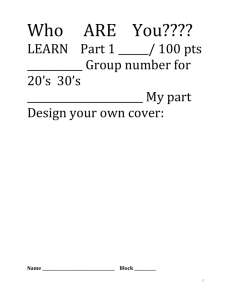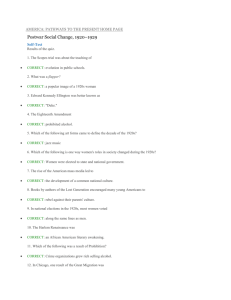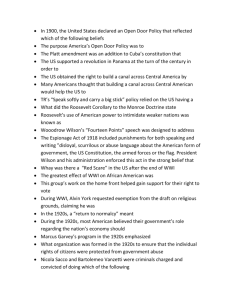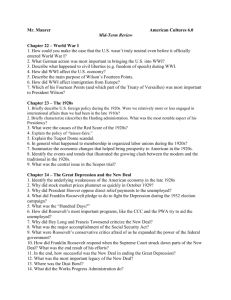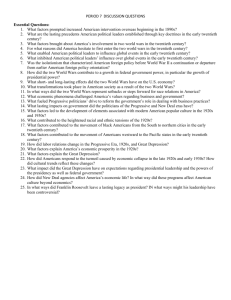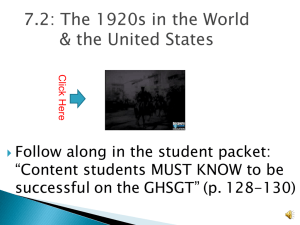Did I Learn It
advertisement
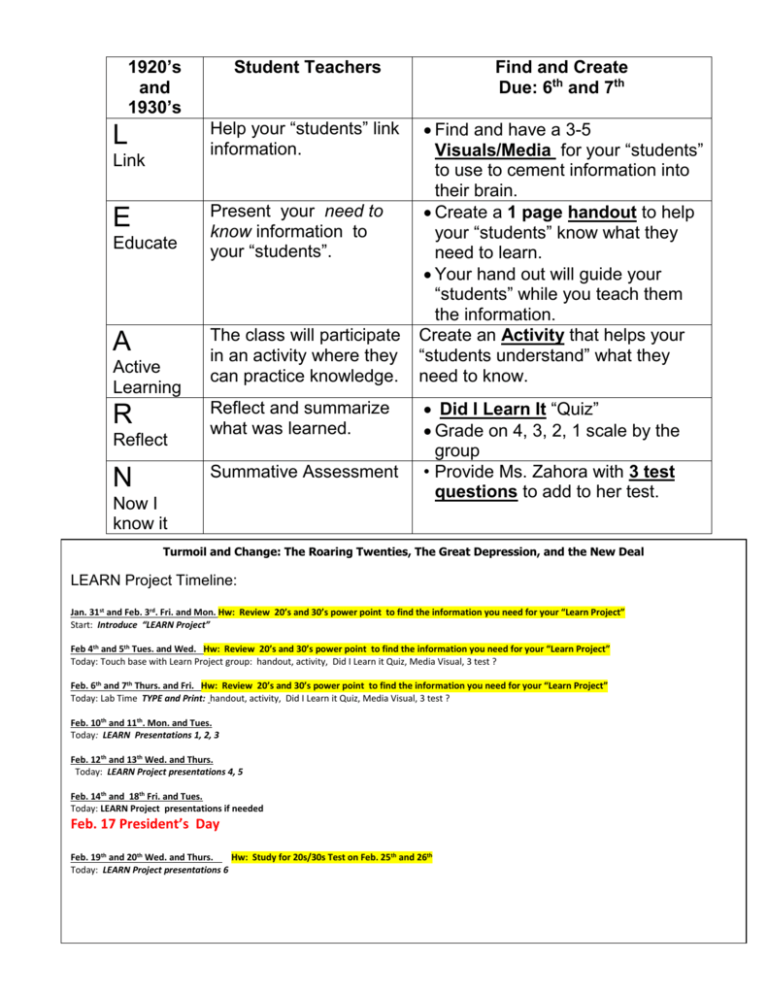
1920’s and 1930’s L Link E Educate A Active Learning R Reflect Student Teachers Find and Create Due: 6th and 7th Help your “students” link information. Find and have a 3-5 Visuals/Media for your “students” to use to cement information into their brain. Create a 1 page handout to help your “students” know what they need to learn. Your hand out will guide your “students” while you teach them the information. Create an Activity that helps your “students understand” what they need to know. Present your need to know information to your “students”. The class will participate in an activity where they can practice knowledge. Reflect and summarize what was learned. Summative Assessment N Now I know it Did I Learn It “Quiz” Grade on 4, 3, 2, 1 scale by the group • Provide Ms. Zahora with 3 test questions to add to her test. Turmoil and Change: The Roaring Twenties, The Great Depression, and the New Deal LEARN Project Timeline: Jan. 31st and Feb. 3rd. Fri. and Mon. Hw: Review 20’s and 30’s power point to find the information you need for your “Learn Project” Start: Introduce “LEARN Project” Feb 4th and 5th Tues. and Wed. Hw: Review 20’s and 30’s power point to find the information you need for your “Learn Project” Today: Touch base with Learn Project group: handout, activity, Did I Learn it Quiz, Media Visual, 3 test ? Feb. 6th and 7th Thurs. and Fri. Hw: Review 20’s and 30’s power point to find the information you need for your “Learn Project” Today: Lab Time TYPE and Print: handout, activity, Did I Learn it Quiz, Media Visual, 3 test ? Feb. 10th and 11th. Mon. and Tues. Today: LEARN Presentations 1, 2, 3 Feb. 12th and 13th Wed. and Thurs. Today: LEARN Project presentations 4, 5 Feb. 14th and 18th Fri. and Tues. Today: LEARN Project presentations if needed Feb. 17 President’s Day Feb. 19th and 20th Wed. and Thurs. Hw: Study for 20s/30s Test on Feb. 25th and 26th Today: LEARN Project presentations 6 1 1 What everyone needs to understand Questions to Ask What does everyone need to know? Technology extended progress into all areas of American life, including neglected rural areas. How was social/people and economic/$ life in the early twentieth century different from that in the late nineteenth century? What factors increased factory and labor productivity? Results of improved transportation brought about by affordable automobiles Greater mobility (movement of people) Creation of jobs Growth of transportation-related industries (road construction, oil, steel, automobile) Movement to suburban areas Invention of the airplane The Wright brothers: Why was flight important? Use of the assembly line Henry Ford, automobile Rise of mechanization (machines) Research from power point: 2 What everyone needs to understand Questions to Ask What does everyone need to know? 2 Technology extended progress into all areas of American life, including neglected rural areas. How was social/people and economic/$ life in the early twentieth century different from that in the late nineteenth century? What factors increased factory and labor productivity (making more to sell)? Communication changes Increased availability of telephones Development of the radio and broadcast industry Development of the movies Ways electrification changed American life Labor-saving products (e.g., washing machines, electric stoves, water pumps) Electric lighting Entertainment (e.g., radio) Improved communications Research from Power point: 3 What everyone needs to understand Questions to Ask 3 Reforms (change by law) in the early twentieth century could not legislate how all people behaved. Economic conditions and violence led to the migration of people. What was prohibition, and how effective was it? Why did African Americans migrate to northern cities? What does everyone need to know? What were the economic changes during the early twentieth century? Prohibition was imposed by a constitutional amendment that made it illegal to manufacture, transport, and sell alcoholic beverages. (18th Amendment) Results of prohibition Speakeasies were created as places for people to drink alcoholic beverages. Bootleggers made and smuggled alcohol illegally and promoted organized crime. Repealed/Ended by the 21st Amendment. Great Migration north and west Jobs for African Americans in the South were scarce and low paying. African Americans faced discrimination and violence in the South. African Americans moved to cities in the North and Midwest in search of better employment opportunities. African Americans also faced discrimination and violence in the North and Midwest. Research from Power point: 4 What everyone needs to understand Questions to Ask 4 The 1920s and 1930s were important decades for American art, literature, and music. Who were the leaders in art, literature, and music during the 1920s and 1930s? What were the contributions of these leaders? How did they change America? What does everyone need to know? Cultural climate of the 1920s and 1930s Art: Georgia O’Keeffe, an artist known for urban scenes and, later, paintings of the Southwest Literature: F. Scott Fitzgerald, a novelist who wrote about the Jazz Age of the 1920s; John Steinbeck, a novelist who portrayed the strength of poor migrant workers during the 1930s Music: Aaron Copland and George Gershwin, composers who wrote uniquely American music Research from Power point: 5 What everyone needs to understand Questions to Ask 5 The 1920s and 1930s were important decades for American art, literature, and music. The leaders of the Harlem Renaissance drew upon the heritage of African American culture to establish themselves as powerful forces for cultural change. Who were the leaders in art, literature, and music during the 1920s and 1930s? What were the contributions of these leaders? How did the Harlem Renaissance influence American life (change America)? What does Harlem Renaissance everyone African American artists, writers, and musicians based need to in Harlem revealed the freshness and variety of African know? American culture. Art: Jacob Lawrence, a painter who chronicled the experiences of the Great Migration through art Literature: Langston Hughes, a poet who combined the experiences of African and American cultural roots Music: Duke Ellington and Louis Armstrong, jazz musicians; Bessie Smith, a blues singer The popularity of these artists spread beyond Harlem to the rest of society. Research from Power point: 6 What everyone needs to understand 6 The optimism “positive vibe” of the 1920s concealed problems in the American economic $ system and attitudes about the role of government in controlling the economy. The Great Depression had a widespread and severe impact on American life. Questions to Ask Franklin Roosevelt’s New Deal used government programs to help the nation recover from the Depression What were the causes of the Great Depression? How were the lives of Americans affected by the Great Depression? What does everyone need to know? What were the major features of the New Deal? Causes of the Great Depression People over-speculated on stocks, using borrowed money that they could not repay when stock prices crashed. What does over speculation mean? The Federal Reserve failed to prevent the collapse of the banking system. What was its’ job? High tariffs discouraged international trade. Impact on Americans A large number of banks and other businesses failed. One-fourth/25% of workers were without jobs. Large numbers of people were hungry and homeless. Farmers’ incomes fell to low levels, lost farms. Major features of the New Deal Government put people to work and paid them Social Security Federal work programs Environmental improvement programs Farm assistance programs Increased rights for labor Research 7 8


